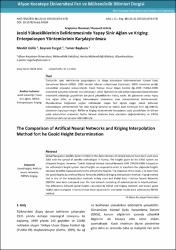| dc.contributor.author | Güllü, Mevlüt | |
| dc.contributor.author | Turgut, Bayram | |
| dc.contributor.author | Baybura, Tamer | |
| dc.date.accessioned | 2017-10-02T07:53:23Z | |
| dc.date.available | 2017-10-02T07:53:23Z | |
| dc.date.issued | 2016 | |
| dc.identifier.issn | 2149-3367 | |
| dc.identifier.uri | http://fenbildergi.aku.edu.tr/wp-content/uploads/2016/12/035505-674-678.pdf | |
| dc.identifier.uri | http://hdl.handle.net/11630/4565 | |
| dc.description.abstract | Türkiye’de uydu tekniklerinin yaygınlaşması ile düşey datumların belirlenmesinde Küresel Uydu
Konumlama Sistemi (GNSS) 2001 yılından itibaren kullanılmaya başlamıştır. GNSS sisteminin verdiği
yükseklikler elipsoidal yüksekliklerdir. Fakat Türkiye Ulusal Düşey Kontrol Ağı-1999 (TUDKA-1999)
ortometrik yükseklik sistemini esas almaktadır. GNSS ölçmeleri ile elde edilen elipsoidal yüksekliklerden
ortometrik yüksekliğe geçebilmek için jeoid yüksekliklerine ihtiyaç vardır. Bu çalışmanın amacı Yapay
Sinir Ağları (YSA) ve Kriging Enterpolasyon yöntemiyle jeoid yüksekliklerinin belirlenmesidir.
Afyonkarahisar bölgesinde seçilen noktalardan oluşan test ağında yaygın olarak kullanılan
enterpolasyon yöntemlerinde biri olan Kriging yöntemi ve Radyal Bazlı Fonksiyon Sinir Ağı (RBFSA)
yöntemleri karşılaştırılmıştır. RBFSA ve Kriging yöntemleriyle hesaplanan jeoid yükseklikleri ile bilinen
jeoid yükseklikleri arasındaki farklar karesel ortalama hata yönünden değerlendirilmiş ve RBFSA
yöntemiyle daha iyi sonuçlar elde edilmiştir. | en_US |
| dc.description.abstract | Global Navigation Satellite System (GNSS) in the determination of vertical datums have been used since
2001 with the spread of satellite technologies in Turkey. The heights given by the GNSS system are
ellipsoidal heights. However, Turkish National Vertical Control Network-1999 (TNVCN-1999) is based on
the orthometric height system. Geoid heights are required in order to transform the ellipsoidal heights
obtained by GNSS measurements to the orthometric heights. The objective of this study is to determine
the geoid heights by Artificial Neural Networks (ANN) and Kriging interpolation method. Kriging method
that is one of the interpolation methods widely used and Radial Basis Function Neural Networks
(RBFNN) have been compared over the test network consisting of selected points in Afyonkarahisar.
The differences between geoid heights calculated by RBFSA and Kriging methods and known geoid
heights were evaluated in terms of root mean square error and better results were achieved by RBFNN
method. | en_US |
| dc.language.iso | tur | en_US |
| dc.publisher | Afyon Kocatepe Üniversitesi, Fen ve Mühendislik Bilimleri Dergisi | en_US |
| dc.identifier.doi | 10.5578/fmbd.40384 | en_US |
| dc.rights | info:eu-repo/semantics/openAccess | en_US |
| dc.subject | Jeoid yüksekliği | en_US |
| dc.subject | Yapay sinir ağları | en_US |
| dc.subject | RBFSA | en_US |
| dc.subject | Enterpolasyon | en_US |
| dc.subject | Kriging | en_US |
| dc.title | Jeoid Yüksekliklerinin Belirlenmesinde Yapay Sinir Ağları ve Kriging Enterpolasyon Yöntemlerinin Karşılaştırılması | en_US |
| dc.title.alternative | The Comparison of Artifical Neural Networks and Kriging Interpolation Method fort he Geoid Height Determination | en_US |
| dc.type | article | en_US |
| dc.relation.journal | Fen ve Mühendislik Bilimleri Dergisi | en_US |
| dc.department | Afyon Kocatepe Üniversitesi, Mühendislik Fakültesi, Harita Mühendisliği Bölümü | en_US |
| dc.identifier.volume | 16 | en_US |
| dc.identifier.startpage | 674 | en_US |
| dc.identifier.endpage | 678 | en_US |
| dc.identifier.issue | 3 | en_US |
| dc.relation.publicationcategory | Makale - Ulusal Hakemli Dergi - Kurum Yayını | en_US |



















